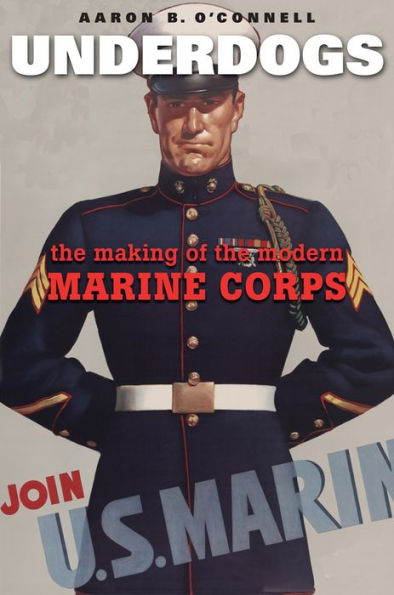

Paperback
-
PICK UP IN STORECheck Availability at Nearby Stores
Available within 2 business hours
Related collections and offers
Overview
Aaron O’Connell focuses on the period from World War II to Vietnam, when the Marine Corps transformed itself from America’s least respected to its most elite armed force. He describes how the distinctive Marine culture played a role in this ascendancy. Venerating sacrifice and suffering, privileging the collective over the individual, Corps culture was saturated with romantic and religious overtones that had enormous marketing potential in a postwar America energized by new global responsibilities. Capitalizing on this, the Marines curried the favor of the nation’s best reporters, befriended publishers, courted Hollywood and Congress, and built a public relations infrastructure that would eventually brand it as the most prestigious military service in America.
But the Corps’ triumphs did not come without costs, and O’Connell writes of those, too, including a culture of violence that sometimes spread beyond the battlefield. And as he considers how the Corps’ interventions in American politics have ushered in a more militarized approach to national security, O’Connell questions its sustainability.

Product Details
| ISBN-13: | 9780674416819 |
|---|---|
| Publisher: | Harvard University Press |
| Publication date: | 10/06/2014 |
| Pages: | 400 |
| Product dimensions: | 5.40(w) x 8.20(h) x 1.20(d) |
About the Author
Read an Excerpt
Chapter 2: The Privates’ War and the Homefront in the 1940s
There is something about the Marines—I don’t know what it is—that draws them together and makes them one.
—Frances Newman, age eighteen, June 22, 1945
The eighteen candles on Frances Newman’s birthday cake had to be lit twice. The first time she blew them out too quickly and the photographers crowding around her missed the shot. Perhaps she was unaware of the time needed to frame a good photograph, or maybe she was nervous about all the attention and the guests. The handsome Marine in dress blues standing next to her—her “substitute brother” the newspapers would call him—probably increased her anxiety, for she had met him just hours before. She may even have rushed through the ceremony on purpose. All the parties, gifts, radio interviews, and celebrity trips to New York would not bring her real brother back; Bob had been killed four months earlier on the island of Iwo Jima. Nevertheless, she smiled through the entire party the Marines had organized for her. “There was a lump in my throat for a long time,” Frances wrote later, “but I just swallowed it, closed my eyes, and in dreams, Bob and I danced just as we used to do.”
The next morning, Frances, a farmer’s daughter from outside Lumpkin, Georgia, made the front page of The Atlanta Constitution. The Associated Press picked up the story and it appeared around the country, from Los Angeles, California to Lowell, Massachusetts. The papers and radio shows told a story of a courageous young girl’s letter to a Marine general, his response, and a promise fulfilled. They explained the one hundred dollar dress and the flowers the Marines sent Frances from the Pacific, as well as the handsome Marine escort sent down from Atlanta, who, for one night, “will be Bob, come back to fill his promise.” Fan mail flooded the general’s division in the Pacific, as well as the Marine Corps Division of Public Relations in Washington, which had orchestrated the spectacle. Some of the nation’s biggest newspapers ran editorials. “Few incidents of this war have so struck home with Americans. It is not the mere pathos of it—there have been many other equally touching,” wrote The Christian Science Monitor. Rather, what made Frances’ birthday party so special was that “it talks so clearly and genuinely the language of American family life.”
Frances would agree. Though she had always admired her brother’s branch of service, the party and her brother’s death brought her closer to the Marine Corps, making it a second family. She began to call the Marines her “brothers” and herself “their kid sister.” In a thank you note to her brother’s commanding general, written just a week after the party, she remarked: “In the past week and a half, I’ve become more and more acquainted with the United States Marines and the great work they are doing. There is something about the Marines—I don’t know what it is—that draws them together and makes them one. I don’t what that is about the Corps, but there is something and I’ve gotten it too. I’m proud that I have been associated with them, and I have elected myself an honorary member. I’ll be good and I’ll be content to stay a private. I won’t ask for any rank but I’ll do the best job I can in the army and proudly say that I am a Marine.”
Table of Contents
List of Illustrations ix
Preface xi
Introduction: Culture Warriors 1
1 A Harsh and Spiritual Unity 24
2 The Privates' War and the Home Front in the 1940s 61
3 The Politicians and the Guerrillas 98
4 Forgetting Korea 148
5 First to Fight in the 1950s 187
6 Rise of the Amphibious Force-in-Readiness 231
Conclusion: Marine Corps Culture since 1965 268
Abbreviations 281
Notes 283
Acknowledgments 371
Index 373
